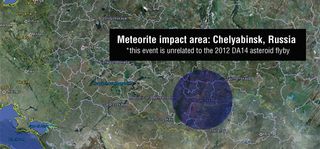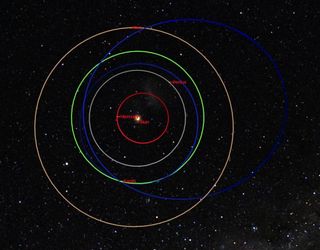
NASA Fireball Website Launches with New Russian Meteor Explosion Details

NASA has launched a new website to share details of meteor explosion events as recorded by U.S. military sensors on secretive spacecraft, kicking off the project with new details of last month's fireball over Chelyabinsk, Russia.
The new "Fireball and Bolide Reports" website, overseen by NASA's Near-Earth Object Program, debuted Friday (March 1) with its first entry: a table with a chronological data summary of the Russian meteor explosion of Feb. 15 gleaned from U.S. Government sensor data. Scientists are calling the event a "superbolide," taken from the term "bolide" typically used for fireballs created by meteors.
Sharing the information publicly is part of a renewed collaboration between the U.S. military and the scientific community.
"And what better way to kick this site off than the Chelyabinsk superbolide … the most energetic recognized-fireball event since Tunguska in 1908," said Don Yeomans, a senior research scientist at the NASA Jet Propulsion Laboratory in Pasadena, Calif. He is also manager of NASA's Near-Earth Object Program Office at JPL.
"This website is meant to be the vehicle for future reports of fireballs/bolides as seen by U.S. government sensors," Yeomans told SPACE.com. "This is the first posting of its kind on this site. Future data on bright fireballs will be added to this table. We won't capture every fireball event … only the unusually bright ones," he said.
"I consider this a major step forward since these fireball events are by far the most frequent impactors into the Earth's atmosphere," Yeomans said. "And these reports will go a long way toward defining the annual flux of small Earth impactors." [Russian Meteor Explosion Explained (Infographic)]
New Russian meteor details
Get the Space.com Newsletter
Breaking space news, the latest updates on rocket launches, skywatching events and more!
The Feb. 15 Russian meteor event is the first entry on this new site, and it provides the following information about the fireball:
Time of maximum brightness:
03:20:33 GMT on Feb. 15
Geographic location of maximum brightness:
Latitude: 54.8 deg. N
Longitude: 61.1 deg. E
Altitude of maximum brightness:
23.3 km (14.5 miles)
Velocity at peak brightness:
18.6 km/s (11.6 miles/s)
Approximate total radiated energy of fireball:
3.75 x 1014 Joules. This is the equivalent of about 90 kilotons of TNT explosives, but it does not represent the total impact energy, which is several times larger than the observed total radiated energy.
Approximate total impact energy of the fireball in kilotons of TNT explosives (the energy parameter usually quoted for a fireball):
440 kilotons.

New fireball agreement
This public release of government detector data was made possible by a newly signed memorandum of agreement (MOA) between NASA’s Science Mission Directorate and Headquarters Air Force Space Command Air, Space and Cyberspace Operations Directorate.
The MOA was signed on Jan. 18, said Capt. Chris Sukach, spokesperson for U.S. Air Force Space Command at Peterson Air Force Base in Colorado. For security reasons, the actual MOA is classified, she told SPACE.com.
As a result of the agreement, Sukach said, NASA's Near Earth Object (NEO) Program is receiving information on bolide/fireball events based on analysis of data collected by U.S. Government sensors.
"Data on the recent Chelyabinsk event has been released," Sukach said.
Sukach added that when Air Force Space Command receives data on bolide events, it pushes that data to the NASA Near Earth Object Office. "From then on, it is a NASA-owned process, but our understanding is NASA distributes the information via the publically-accessible Near Earth Object Office website to assist the scientific community’s investigation of bolides," she said.
According to Don Yeomans and Paul Chodas, also of the NASA/JPL Near-Earth Object Program office, the Russian fireball was technically a "superbolide" that was observed on the morning of Feb. 15 in the skies near Chelyabinsk, Russia.
The object was a relatively small asteroid, approximately 55 to 65 feet (17 to 20 meters) in size. As it roared through the Earth's atmosphere at high speed and a shallow angle, the asteroid released a huge amount of energy. The object broke apart at high altitude, producing a shower of pieces of various sizes that fell to the ground as meteorites. [Russian Meteor Fragments Found (Video)]
"The fireball was observed not only by video cameras and low-frequency infrasound detectors, but also by U.S. Government sensors," Yeomans and Chodas said. "As a result, the details of the impact have become clearer. There is no connection between the Russian fireball event and the close approach of asteroid 2012 DA14, which occurred just over 16 hours later."

Congress wants to know about NEOs
Congressional action on NEOs for this year, spurred in part by the Russian event, was initially slated kick off on March 6 during a House subcommittee hearing, but the meeting was postponed due to weather concerns. The meeting is now scheduled for Tuesday, March 19.
The full committee of the House Committee on Science, Space and Technology is expected to hold a multi-panel hearing on "Threats from Space: a Review of U.S. Government Efforts to Track and Mitigate Asteroids and Meteors."
Slated to testify on one panel is John Holdren, White House science officer; General William Shelton, commander of the U.S. Air Force Space Command; and Charles Bolden, NASA's chief.
More info: NASA's Fireball and Bolide Reports website.
Leonard David has been reporting on the space industry for more than five decades. He is former director of research for the National Commission on Space and a past editor-in-chief of the National Space Society's Ad Astra and Space World magazines. He has written for SPACE.com since 1999.
Follow us @Spacedotcom, Facebook or Google+. Originally published on SPACE.com.
Join our Space Forums to keep talking space on the latest missions, night sky and more! And if you have a news tip, correction or comment, let us know at: community@space.com.

Leonard David is an award-winning space journalist who has been reporting on space activities for more than 50 years. Currently writing as Space.com's Space Insider Columnist among his other projects, Leonard has authored numerous books on space exploration, Mars missions and more, with his latest being "Moon Rush: The New Space Race" published in 2019 by National Geographic. He also wrote "Mars: Our Future on the Red Planet" released in 2016 by National Geographic. Leonard has served as a correspondent for SpaceNews, Scientific American and Aerospace America for the AIAA. He has received many awards, including the first Ordway Award for Sustained Excellence in Spaceflight History in 2015 at the AAS Wernher von Braun Memorial Symposium. You can find out Leonard's latest project at his website and on Twitter.
